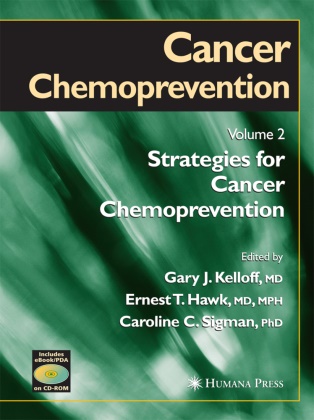Share
Fr. 239.00
Ernest T. Hawk, Gary J. Kelloff, Caroline C. Sigman
Cancer Chemoprevention - Volume 2: Strategies for Cancer Chemoprevention
English · Mixed media product
Shipping usually within 6 to 7 weeks
Description
Despite significant advances in cancer treatment and measures of neoplastic progression, drug effect (or early detection, overall cancer incidence has increased, pharmacodynamic markers), and markers that measure cancer-associated morbidity is considerable, and overall prognosis as well as predict responses to specific therapy. cancer survival has remained relatively flat over the past All these biomarkers have the potential to greatly augment several decades (1,2). However, new technology the development of successful chemoprevention therapies, allowing exploration of signal transduction pathways, but two specific types of biomarkers will have the most identification of cancer-associated genes, and imaging of immediate impact on successful chemopreventive drug tissue architecture and molecular and cellular function is development-those that measure the risk of developing increasing our understanding of carcinogenesis and cancer invasive life-threatening disease, and those whose mo- progression. This knowledge is moving the focus of cancer lation can "reasonably predict" clinical benefit and, therapeutics, including cancer preventive treatments, to therefore, serve as surrogate endpoints for later-occurring drugs that take advantage of cellular control mechanisms clinical disease. Thus far, the biomarker that best measures to selectively suppress cancer progression. these two phenomena is intraepithelial neoplasia (IEN) Carcinogenesis is now visualized as a multifocal, because it is a near obligate precursor to cancer.
List of contents
Chemopreventive Agent Development Science.- Characterization of Natural Product Chemopreventive Agents.- Preclinical Animal Models for the Development of Cancer Chemoprevention Drugs.- Potential Use of Transgenic Mice in Chemoprevention Studies.- Modeling Human Colorectal Cancer in Mice for Chemoprevention Studies.- Pathology of Incipient Neoplasia.- Quantitative Nuclear Grade.- Enabling Discovery Through Online Cancer Genome Databases and Analytic Tools.- Functional Genomics for Identifying Surrogate Endpoint Biomarkers in Breast Cancer Chemoprevention.- Clinical Applications of Proteomics.- Bioinformatics and Whole-Genome Technologies.- Models of Absolute Risk.- Genetic Polymorphisms and Risk Assessment for Cancer Chemoprevention.- Design Issues in Prostate Cancer Chemoprevention Trials.- Recruitment Strategies for Cancer Prevention Trials.- Cancer Chemoprevention at Major Cancer Target Sites.- Prostate Cancer Prevention.- Use of PSA to Evaluate Risk and Progression of Prostate Cancer.- Clinical Approaches to Discovering and Testing New Breast Cancer Prevention Drugs.- Ductal Lavage.- Counteracting Estrogen as Breast Cancer Prevention.- Chemoprevention of Colorectal Cancer.- Screening in Risk Evaluation and Prevention of Colorectal Cancer.- Strategies in Lung Cancer Chemoprevention.- Lung Cancer Chemoprevention.- Bladder Cancer.- Barrett's Esophagus.- Endoscopic Detection of Esophageal Neoplasia.- Chemoprevention Strategies for Esophageal Squamous Cell Carcinoma.- Chemoprevention of Upper Aerodigestive Tract Cancer.- Chemoprevention of Oral Cancer.- Strategies in Skin Cancer Chemoprevention.- Opportunities and Challenges for Skin Cancer Chemoprevention.- Progress in Developing Effective Chemoprevention Agents for Cervical Neoplasia.- Immunoprevention of CervicalCancer.- Objective Biomarkers in Endometrioid-Type Endometrial Carcinogenesis.- Epithelial Ovarian Cancer.- Strategies for Chemoprevention in Pancreatic Cancer.- Clinical Strategies for Chemoprevention of Liver Cancer.- Chemoprevention.
Summary
Despite significant advances in cancer treatment and measures of neoplastic progression, drug effect (or early detection, overall cancer incidence has increased, pharmacodynamic markers), and markers that measure cancer-associated morbidity is considerable, and overall prognosis as well as predict responses to specific therapy. cancer survival has remained relatively flat over the past All these biomarkers have the potential to greatly augment several decades (1,2). However, new technology the development of successful chemoprevention therapies, allowing exploration of signal transduction pathways, but two specific types of biomarkers will have the most identification of cancer-associated genes, and imaging of immediate impact on successful chemopreventive drug tissue architecture and molecular and cellular function is development—those that measure the risk of developing increasing our understanding of carcinogenesis and cancer invasive life-threatening disease, and those whose mo- progression. This knowledge is moving the focus of cancer lation can “reasonably predict” clinical benefit and, therapeutics, including cancer preventive treatments, to therefore, serve as surrogate endpoints for later-occurring drugs that take advantage of cellular control mechanisms clinical disease. Thus far, the biomarker that best measures to selectively suppress cancer progression. these two phenomena is intraepithelial neoplasia (IEN) Carcinogenesis is now visualized as a multifocal, because it is a near obligate precursor to cancer.
Additional text
"...comprehensive review of the literature concerning current and future cancer chemoprevention strategies... provide(s) a basis for future developments." - The Annals of Pharmacology
"...a good reference source for students and experts alike who are interested in evaluating cancer risk, strategies available to try to prevent certain cancers developing and how the incidence of cancer can be reduced b the use of therapeutic agents. -Newletter of the British Toxicology Society
Report
"...comprehensive review of the literature concerning current and future cancer chemoprevention strategies... provide(s) a basis for future developments." - The Annals of Pharmacology
"...a good reference source for students and experts alike who are interested in evaluating cancer risk, strategies available to try to prevent certain cancers developing and how the incidence of cancer can be reduced b the use of therapeutic agents. -Newletter of the British Toxicology Society
Product details
| Assisted by | Ernest T. Hawk (Editor), Gary J. Kelloff (Editor), Caroline C. Sigman (Editor) |
| Publisher | Springer, Berlin |
| Languages | English |
| Product format | Mixed media product |
| Released | 23.02.2011 |
| EAN | 9781588290779 |
| ISBN | 978-1-58829-077-9 |
| No. of pages | 543 |
| Weight | 1809 g |
| Illustrations | XXI, 543 p. With CD-ROM. |
| Series |
Cancer Drug Discovery and Development Cancer Drug Discovery and Development |
| Subjects |
Natural sciences, medicine, IT, technology
> Medicine
> Clinical medicine
B, Medicine, Oncology, positron emission tomography |
Customer reviews
No reviews have been written for this item yet. Write the first review and be helpful to other users when they decide on a purchase.
Write a review
Thumbs up or thumbs down? Write your own review.

